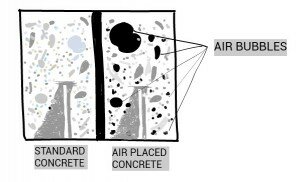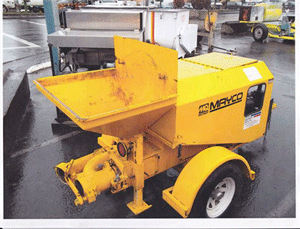The concrete industry is constantly looking into innovative techniques that can improve the product quality, its lifetime and sometimes cut cost. If you live in an area of the world that is known for harsh and long winters, as a concrete contractor, you are facing additional factors and challenges that, let’s say, a contractor in California or Florida, does not’t have to worry about. These external factors are not only harsh to the local residents but also to the concrete structures and can significantly shorten their strength, look and lives.
 A new technique called ‘air-placed’ or ‘entrained air’ concrete, invented about 50 years ago, is helping reducing the impact of frequent freezing and exposure to deicing chemicals on concrete and improve its resistance. Anyone who has ever accidentally placed a can of soda in their freezer and forgotten about it, knows that contraction and expansion can be messy! The same goes for concrete! Water expands when freezing and breaks the tensile strength of concrete, resulting in cracks and scales. This problem not only affects the aesthetics of what was built but also its structural quality, which is a bigger problem.
A new technique called ‘air-placed’ or ‘entrained air’ concrete, invented about 50 years ago, is helping reducing the impact of frequent freezing and exposure to deicing chemicals on concrete and improve its resistance. Anyone who has ever accidentally placed a can of soda in their freezer and forgotten about it, knows that contraction and expansion can be messy! The same goes for concrete! Water expands when freezing and breaks the tensile strength of concrete, resulting in cracks and scales. This problem not only affects the aesthetics of what was built but also its structural quality, which is a bigger problem.
THE PROCESS
As its name implies, added air is incorporated in fresh concrete mixtures (using a proportioned combination of Portland cement, aggregates and water) and used to expel the material. The force of the air jet compacts the material. This process creates extra tiny spaces (we are talking smaller than the head of a pin) or bubbles that lessens the pressure that occurs with the expansion of water when it freezes and after it thaws off.
This process can be achieved a number of ways:
1. By using air-placed Portland cement
2. With a shearing action of mixer blades breaking up the air into tiny bubbles
3. By delivering compressed air at the nozzle by a separate air line
4. By adding entraining admixtures to stabilize the air voids
The process does require careful supervision during the mixing of the concrete. If you are using a separate air line, you will need a nozzleman helper, responsible for the air lance, to blow out excess material in the forms, steel etc. Always start at the bottom, when shooting walls, beams. You will know you have reached the maximum height and thickness, when the material begins to sag!
How much entrained air should be added to the mix? Anywhere between 5-8 percent of the volume of the concrete, with some variations are allowed if other conditions require it. It is recommended to take a sample every 75 m³ (100 yd³). You should have a minimum of 0.028 m³ (1 ft³). Avoid using the first and last batch for the sample.
WHERE TO USE IT
While it has mostly been used in regions with harsh winters, air-placed or entrained air can be used virtually in all concrete applications and structures. It is now being used in very hot countries where extreme high temperatures are also causing concrete to expand and contract. In terms of applications, entrained air concrete is found in heavy constructions, bridges, roads, large structures but also for water control, water storage, slope protection and special architecture features etc.
ADVANTAGES
Air-placed concrete adhered well to structural steel and provides great protection against corrosion. It improved the steel’s rigidity. The usage of entraining admixtures not only produces a finished product that is highly resistant to wetting and drying, freezing and thawing cycles, but it also provides greater workability and durability. Something that could be used on all jobs!
EQUIPMENT TO USE
Concrete line pumps is what you will need to make air entrained concrete.
You will also need an air compressor capable of producing a minimum of 100 cu ft. of air per minute per nozzle.
OTHER VARIABLES TO CONSIDER
The ways concrete is batched, mixed, the time and speed of mixing, transport, finishing and temperature can also affect the air content of concrete. To find out more about the effects of Concrete Ingredients on Air Content or the effects of Production and Construction Variables on Air Content, go to : http://www.cement.org/tech/pdfs/PL981.pdf.
You can also order the Manual on Control of Air Content in Concrete (EB116), published in 1998 by NRMCA and PCA.
Visit United Equipment Sales, and check out their special deals on used and new line pumps or call us at: (503)283-2101, if you have more questions.
